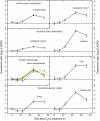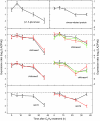Ethylene-induced differential gene expression during abscission of citrus leaves
- PMID: 18515267
- PMCID: PMC2486473
- DOI: 10.1093/jxb/ern138
Ethylene-induced differential gene expression during abscission of citrus leaves
Abstract
The main objective of this work was to identify and classify genes involved in the process of leaf abscission in Clementina de Nules (Citrus clementina Hort. Ex Tan.). A 7 K unigene citrus cDNA microarray containing 12 K spots was used to characterize the transcriptome of the ethylene-induced abscission process in laminar abscission zone-enriched tissues and the petiole of debladed leaf explants. In these conditions, ethylene induced 100% leaf explant abscission in 72 h while, in air-treated samples, the abscission period started later and took 240 h. Gene expression monitored during the first 36 h of ethylene treatment showed that out of the 12 672 cDNA microarray probes, ethylene differentially induced 725 probes distributed as follows: 216 (29.8%) probes in the laminar abscission zone and 509 (70.2%) in the petiole. Functional MIPS classification and manual annotation of differentially expressed genes highlighted key processes regulating the activation and progress of the cell separation that brings about abscission. These included cell-wall modification, lipid transport, protein biosynthesis and degradation, and differential activation of signal transduction and transcription control pathways. Expression data associated with the petiole indicated the occurrence of a double defensive strategy mediated by the activation of a biochemical programme including scavenging ROS, defence and PR genes, and a physical response mostly based on lignin biosynthesis and deposition. This work identifies new genes probably involved in the onset and development of the leaf abscission process and suggests a different but co-ordinated and complementary role for the laminar abscission zone and the petiole during the process of abscission.
Keywords: Citrus clementina; cDNA microarray; expression profiling; laminar abscission zone; mandarin; petiole.
Figures










References
-
- Agusti J, Zapater M, Iglesias DJ, Cercos M, Tadeo FR, Talon M. Differential expression of putative 9-cis-epoxycarotenoid dioxygenases and abscisic acid accumulation in water-stressed vegetative and reproductive tissues of citrus. Plant Science. 2007;172:85–94.
-
- Abeles FB, Morgan PW, Saltveit ME. Ethylene in plant biology. 2nd edn. San Diego: Academic Press; 1992.
-
- Addicot FT. Abscission. Berkeley, California: University of California Press; 1982.
-
- Azevedo H, Conde C, Geros H, Tavares RM. The non-host pathogen Botrytis cinerea enhances glucose transport in Pinus pinaster suspension-cultured cells. Plant and Cell Physiology. 2006;47:290–298. - PubMed
-
- Belfield EJ, Ruperti B, Roberts JA, McQueen-Mason S. Changes in expansin activity and gene expression during ethylene-promoted leaflet abscission in Sambucus nigra. Journal of Experimental Botany. 2005;56:817–823. - PubMed
Publication types
MeSH terms
Substances
LinkOut - more resources
Full Text Sources
Molecular Biology Databases
Research Materials

